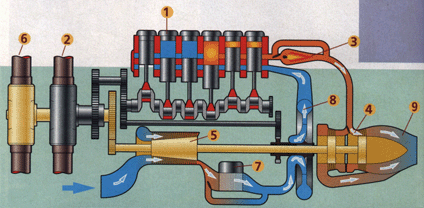
The Napier Nomad 1
The Napier Nomad compound engine described below was an attempt to provide the 1950s with a highly-economical, efficient aircraft engine for long-range operations. It was developed under the leadership of Napier Chief Engineer, Ernest E. Chatterton, from about 1945 to 1955.
It's the only engine I know of that uses turbocharging, supercharging and the turbocompound principle.

1: The piston engine itself: a 12-cylinder, 41-litre, opposed-piston two-stroke diesel.
2: This propeller is driven by the crankshaft.
3: Yes, there is an afterburner in the exhaust.
4. The exhaust gases drive an axial multistage turbine. With the valve [4], half the turbine can be closed off.
5. The turbine drives an axial multistage compressor.
6. The turbine also drives the second propeller.
7. The hot air from the supercharger is led through an intercooler.
8. And then through a radial supercharger that is powered by the crankshaft.
9. The thrust from the exhaust gases is also made useful.
The afterburner and intercooler have shunt ducting, so the engine can be run in a number of modes depending on power requirements.
The result is a very fuel-efficient engine (163 g/bhp/hr) that produced 3000 bhp plus 1.4 kN of thrust. It was rather hard to get it to run well, so it never progressed beyond the prototype stage. Applications: (UK) Avro Lincoln (testbed), Shackleton (proposed); Blackburn and General Beverley (proposed).
A simplified version was also tried: the Nomad 2, with a single propeller, without the supercharger, and with the turbocharger linked to the crankshaft instead of the second propeller. The Nomad 2 (or "E 145") didn't see production either. Applications: (UK) Airspeed Ambassador freighter (proposed); Avro Shackleton (proposed); Blackburn and General Beverley (proposed).

Nomad 2 engine
more on Nomad development and testing